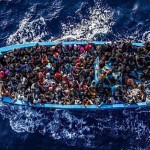The European Agenda on Migration, published May 13 and implemented throughout the past summer, is a fascinating initiative. The policy has four stated “pillars”: (1) reducing incentives for unauthorized or “irregular” migration; (2) border management — which is understood as both border enforcement and saving the lives of migrants at risk; (3) a “strong common asylum policy” and (4) providing new avenues for legal migration. This agenda presents the EU’s most comprehensive attempt to address a surging number of asylum seekers and migrants now Continue reading →
Israeli Author Yoram Kaniuk passed away exactly one year ago, on June 8, 2013. His somewhat rambling and quasi-biographical essay Angels (“Mal’achim”) was published posthumously as a small book. The author is depicted on the book’s jacket in a long black coat. Standing on top of a lamppost like a crow, he overlooks the urban skyline of Tel-Aviv. White wings attached to his back suggest that he is the angel in the book’s title.
While the planned attack on Syria now seems to be deferred, the administration’s arguments supporting it will likely resurface. These arguments have admittedly been somewhat stuttering. Yet they will almost inevitably remain resources to be pulled up and reused, sooner or later. What can be said about the intervention’s purported justification from a human rights perspective? And perhaps more to the point, what would that perspective be?
“This norm against using chemical weapons,” explained Obama in his Tuesday Remarks Before Meeting with Members of the Congress, “is there for a reason: Because we recognize that there are certain weapons that, when used, can not only end up resulting in grotesque deaths, but also can end up being transmitted to non-state actors.”
The question of high-seas interdiction of asylum seekers has not come before the United States Supreme Court ever since Sale v. Haitian Centers Council. A comparative perspective, however, reveals quite a different story.

